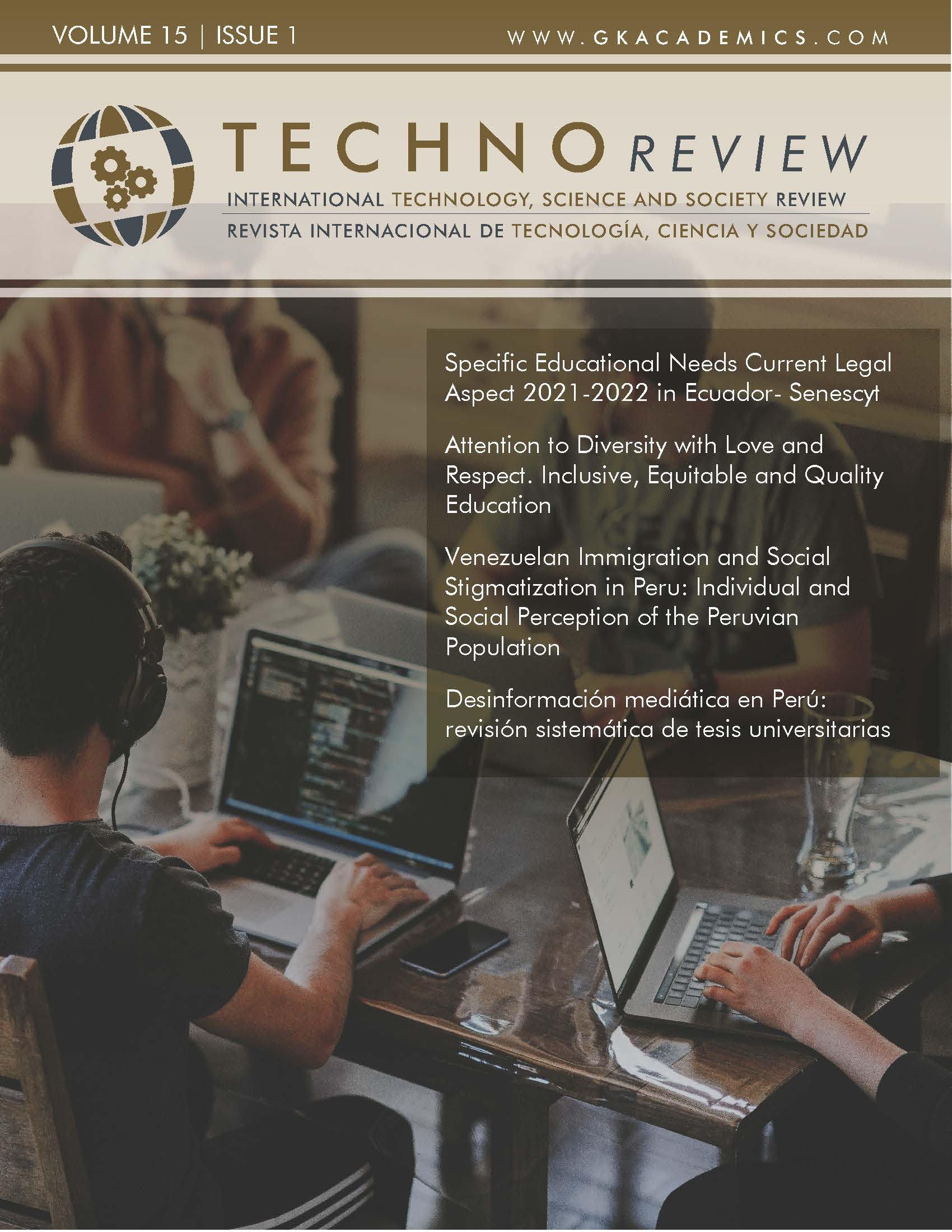Evaluation of the usability of the usability of a medical assistance software applying heuristic rules
DOI:
https://doi.org/10.37467/revtechno.v15.5110Keywords:
Usability, Heuristic rules, Telemedicine, Medical Assistance, SoftwareAbstract
The objective of this research is to evaluate the usability of a telemedicine system developed by the authors through the RUP (Rational Unified Process) methodology, since it is a rigorous method whose purpose is to ensure the production of high-quality software. Usability was evaluated by a group of experts using an instrument based on the Nielsen heuristic rules model. The results indicate that the usability is between "very good" and "excellent" so it is very acceptable. However, some items with low value were presented as recognition before I remember, derived from the fact that the links of the system are not easily identified by the user, therefore, derived from the above, the corresponding improvements will be made.
References
Alcocer, EVG, Chávez, MIG and Cardoso, JLC (2023). Use of ICT as a replacement for practices in real scenarios of careers in the health area used during the COVID-19 contingency. RIESED-International Journal of Educational Systems Studies, 3 (14), 613-630.
Brumme, E. (s.f.). Design Principles Reloaded: 13 Important Usability Principles. https://blogs.zeiss.com/digital-innovation/en/13-importantusability-principles/
Campo-Muñoz, W.Y., Ospina-Alarcón, M.A., & Chanchí-Golondrino, G.E. (2022). Proposal for a Tool for the Analysis of Heuristic Usability Evaluations Through Fuzzy Logic. Engineering and Competitiveness, 24(1), e21911095.
Caro, M.D.M., Romero, E.R., Espinosa, M.A.C., & Guerrero, C.D. (2020). Evaluating usability contributions in ICT-IOT solutions for agriculture: A perspective from bibliometrics. Iberian Journal of Information Systems and Technologies, (E28), 681-692.
Chanchí-Golondrino, G. E., Ospina-Alarcón, M. A., & Campo-Muñoz, W. Y. (2022). Tool for the Analysis of Heuristic Evaluations of Usability Through Fuzzy Logic. Engineering and competitiveness, 24(1).
Chavero, A. (2021). Interface Design Principles: The Guide to Excel in UI. Future of People. https://www.crehana.com/blog/desarrollo-web/principios-diseno-deinterfaz/
CONEVAL (2021). Retrieved on April 23, 2023, from https://www.coneval.org.mx/SalaPrensa/Comunicadosprensa/Documents/2021/COMUNICADO_009_MEDICION_POBREZA_2020.pdf
Figueroa, R. G., Solís, C. J., & Cabrera, A. A. (2008). Traditional methodologies vs. agile methodologies. Private Technical University of Loja, School of Computer Science, 9(1), 1-10.
INEGI (2020). National Census of Statistics and Geography. Retrieved from https://www.inegi.org.mx/contenidos/productos/prod_serv/contenidos/espanol/bvinegi/productos/nueva_estruc/702825197520.pdf
Marinovich, N.N., & Palomino, N.L.S. (2019). Method for the evaluation of the Usability of the In-Person Electronic Voting Software-UsabVEP. Peruvian magazine of computing and systems, 2(1).
Melo, S. C. C., López, E. V., Sagñay, M. A. G., & Gavilanes-Sagnay, F. (2023). Evaluation of the accessibility and usability for blind people of educational websites. University and Society, 15(1), 363-372.
Méndez Espinoza, M., del Castillo Palacios, F., Loli Natividad, F., Olivares Córdova, J., & Armas Castañeda, S. (2023). Flipped Class on the Learning Achievement of Communication Research in University Students. Communication, 14(1), 55-62.
Michel, G. S., Garay, S. G., García, A. M., & Reyes, M. R. (2021). Heuristic evaluation of usability for mobile applications on Android. Cuban Journal of Informatics Sciences, 15.
Mitjaneta, M.A., & Moreno, G.E.C. (2022). Design of an Articulated Evaluation Model of Usability and Accessibility for Interactive Systems. ECBTI Working Papers, 3(1).
Molano, J. I. R., Yara, E. S., & García, L. K. J. (2015, June). Model for measuring usability of survey mobile apps, by analysis of usability evaluation methods and attributes. In 2015 10th Iberian Conference on Information Systems and Technologies (CISTI) (pp. 1-6). IEEE.
MONSALVE Fonnegra, G. P., ECHAVARRÍA Cuervo, J. H., & ALVAREZ Gallo, S. M. (2020). Scientometric and bibliometric study as an instrument for trend analysis in higher education. Case industrial engineering and related programs. Spaces Magazine, 41(28).
Murillo, G. R. G., Novoa-Hernández, P., & Rodríguez, R. S. (2019). Usability in Moodle: a meta-analysis based on experiences reported in WOS and Scopus. Iberian Journal of Information Systems and Technologies, (E18), 108-121.
Naranjo-Martínez, D. S., Collazos-Ordóñez, C. A., & Estrada-Esponda, R. D. (2021). Heuristictool, tool to support heuristic evaluations to interactive systems through ontologies. Research, Development and Innovation Journal, 11(2), 401-412.
Nielsen, J. (1995). How to conduct a heuristic evaluation. Nielsen Norman Group, 1(1), 8.
Nielsen, J. (2020). 10 Usability Heuristics for User Interface Design. Nielsen Norman Group. https://www.nngroup.com/articles/tenusability-heuristics/
Pinargote, O. S. B., Merino, M. J. M., Sánchez, C. X. M., & Lucas, H. B. D. (2022). Asperger syndrome in software quality. Multidisciplinary Refereeed Scientific Journal PENTACIENCIAS-ISSN 2806-5794., 4(5), 156-163.
Laáz, K. G. P., Ponce, J. I. P., Valencia, D. G. M., & Tapia, J. S. H. (2022). THE USABILITY OF THE OFFICIAL WEBSITES OF TOURIST DESTINATIONS OF UNWTO MEMBER COUNTRIES. REFCalE: Electronic Magazine Training and Educational Quality. ISSN 1390-9010, 10(2), 235-256.
Tognazzini, B. (2014). First Principles of Interaction Design (Revised & Expanded). https://asktog.com/atc/principles-of-interaction-design/
Santos, A. (2018). 8 golden rules for a better interface design. https://webdesign.tutsplus.com/en/articles/8-golden-rules-for-betterinterface-design--cms-30886
Zapata-Jaramillo, C. M., Zapata-Tamayo, J. S., & Cardona, P. A. N. (2020). Converting events from preconceptual schematics into PL/pgSQL code: software simulation in the fourth industrial revolution. Iberian Journal of Information Systems and Technologies, (39), 18-34.
Downloads
Published
How to Cite
Issue
Section
License
Those authors who publish in this journal accept the following terms:
- Authors will keep the moral right of the work and they will transfer the commercial rights.
- After 1 year from publication, the work shall thereafter be open access online on our website, but will retain copyright.
- In the event that the authors wish to assign an Creative Commons (CC) license, they may request it by writing to publishing@eagora.org







